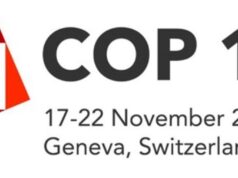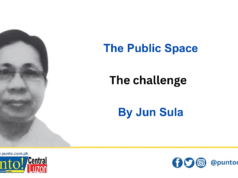SHINING ACHIEVEMENTS more than enough in his lifetime to bask in, Oscar Samson Rodriguez already has amassed.
Outstanding feats in every endeavour he immerses himself in – the solid ground on which his candidacy stands – Rodriguez has accomplished.
It is a wonder then why – in selling himself to the electorate of the third district – he keeps on glorifying the patent hallucination over the flight – yeah, got that right, rather than plight – of the City of San Fernando’s middle class.
This will not endear me to Rodriguez any. As a matter of consequence, animosity if not abomination will even obtain from here. Kamatis I will certainly be in his eyes. But so what?
Rodriguez’s talks on his city’s middle class are an insult to the intelligence of anyone claiming membership with the family homo sapiens, emphasis on sapiens.
Let our column of August 16, 2011 prove this point.
CITY OF SAN FERNANDO – Middle class folk in this capital city of about 300,000 population has increased from a mere 19.1 percent to 59.2 percent, a study from the University of the Assumption (UA) here has revealed.
This, even as business tax collection here was reported to be 100 percent efficient while in the education sector, enrollment rate among local youths was also noted to have jacked up significantly from 57.91 percent to 92.67 percent.
These were among the data revealed by Mayor Oscar Rodriguez in his recent state-of-the-city address here amid statistics revealing that the increase in the local middle class started during his successive terms as mayor starting 2004…
So reads our banner story of August 10-11 written by the erudite Ding Cervantes.
The 100 percent efficiency in business tax collection maybe arguable; the jack up in enrolment, debatable. But nonetheless, both believable.
As to the swell in the middle class, that is simply incredible.
That 40.1 percent increase in the ranks of the middle class within a period of seven years veritably merits Rodriguez the Magsaysay Award, the feat achieved despite the city government’s virtual bankruptcy when he assumed the mayorship, the devastating typhoons and floods that regularly scourge the city, and the deterioration of peace and order starting with last year’s carjackings and killings still recurring to this day.
That 40.1 percent increase in the ranks of the middle class in the city assumes not merely great but most excellent proportions making Rodriguez truly deserving of the Nobel Prize, having been accomplished despite the global economic meltdown that brought even so-called developed nations down on all fours.
Most significant of all, the start of the rise in the city’s middle class – pegged in 2004 – marked the watershed of, nay, sparked the national economic turnaround.
Consider the study of the National Statistical Coordination Board entitled ”Trends and Characteristics of the Middle Class in the Philippines: Is it Expanding or Shrinking?”
Using data from the 1997, 2000 and 2003 Family Income and Expenditure Surveys conducted by the National Statistics Office, the study showed that “as of 2003, less than 1 in 100 families belong to the high income class; about 20 are middle income and 80 are low income. And in a span of 6 years from 1997 to 2003, close to 4 families for every 100 middle income families have been lost to the low income category.”
In 1997 the share of middle class families was 23.0 percent, shrinking “only a bit” to 22.7 in 2000, but further decreasing to 19.9 percent in 2003. The study added.
Came Rodriguez to the mayorship in 2004, the city’s middle class at 19.1 percent – nearly at par with the national level – breaking all barriers, the sound one included, to soar to 59.2 percent within seven years.
Nothing short of a grand miracle there. Maybe, nearing the scale of Moses himself parting the Red Sea.
While the Congregation for the Causes of the Saints at the Vatican may not be apropos this time, Rodriguez though somewhat sainted but still very much kicking, so why haven’t we made a beeline to the nearest Magsaysay Award or Nobel Prize nominating center? Indeed, why haven’t we even joined Rodriguez’s hallelujah chorus?
Like some wag says: Something that is too good to be true, is ever patently untrue.
No, we are not taking Rodriguez to task for his revelations of the state of the middle class in the City of San Fernando.
We are not even questioning the findings, but rather how they were arrived at, and so spectacularly at that.
Assuming that some survey served as the basis of the study of the University of the Assumption, we would very much like to know the survey universe or the number of respondents, demographics, the methodology used, the interview schedule, the survey period, the survey area, other instrumentalities not the least of which is the profile of the researchers.
Not to mention some benchmarks from previous studies on the subject or related readings, as well as validation instruments.
No simple process is undertaking a study of such kind. Just how complex is revealed in that done by the NSCB to find if the country’s middle class is expanding or shrinking, to wit:
One approach in identifying the middle class is through income, as done by the study. The authors conducted cluster analysis on data from the 1997 FIES to create an a priori grouping of families based on income.
This grouping was then used to classify families into the low, middle or high income clusters. The lower and upper income limits of the middle class were then determined based on resulting clusters.
The proposed middle class’ minimum and maximum income were extrapolated to 2000 and 2003 using two series of the Consumer Price Index – one with base year 1994 and another 2000.
Using income limits for the three years, the middle income class is identified.
To identify the total income determinants of the middle income class, the researchers conducted multiple regression analysis on the families classified as middle class. The dependent variable was the log of total household income with a pre-identified list of independent variables, which include educational attainment of household head, occupation, and materials of the housing unit, among others.
They likewise considered the indicators from the 5-point system of the Market and Opinion Research Society of the Philippines where households are classified into five groups based on income using a set of indicators.
Studies done by other researchers on the income classes were likewise used.
The authors also identified the middle class based on socioeconomic characteristics.
The result: “The middle-income class comprises of families who, in 2007, have a total annual income ranging from P251,283 to P2,045,280. Middle-income families also have houses built of strong materials, own a house and lot, a refrigerator and a radio.”
In yet another study, the middle class is marked by indicators as: a) three square meals a day with morning or afternoon snacks; b) dining out once a month or on special occasions like birthdays and anniversaries; c) going to a movie once a month; d) shopping for groceries fortnightly and for clothes/shoes once every two months; e) sending children to schools that are “affordable” but not necessarily public schools; f) owning one motor vehicle, not necessarily brand new but not battered; g) owning a television set, dvd player, component, personal computer, refrigerator, washing machine, microwave, sometimes an air-conditioner; h) having one househelp; and i) own a house and lot in a middle-class area or in a low-cost housing development.
Extrapolating the summary results of the University of the Assumption study on these parameters, we shall find a total of 177,600 Fernandinos (59.2 percent of the population of 300,000) in the relative ease and contentment of day-to-day living.
Do we?
Or, as one wag says: Assumption is the mother of all failures. No pun intended on the source of Rodriguez’s revelations there. No disrespect to Our Lady whose feast we celebrated only last Monday, August 15.
Yeah, in the absence of any cold, hard statistics to support Rodriguez’s claim, we can just take the word of a political pollster friend. That the 59.2 percent was mistakenly appended to the increase in the rank of the middle class in the City of San Fernando.
That 59.2 percent could very well be, he said, the survey’smargin of error.
q q q
JUST stick to your world-class mayor act, Sir. Stop insulting our intelligence.




